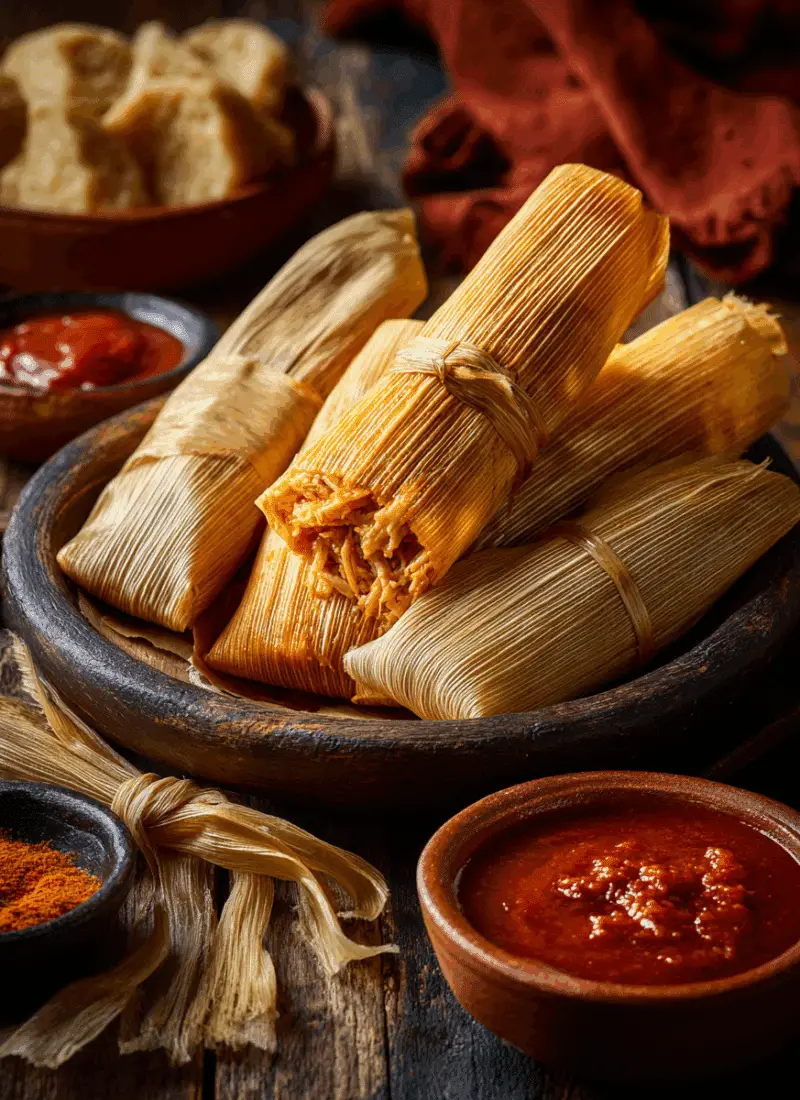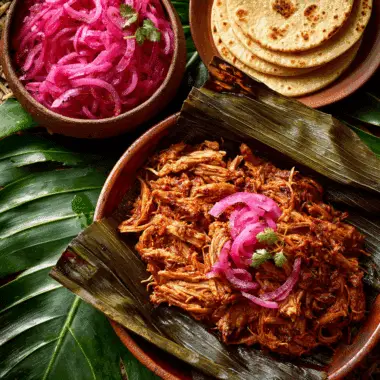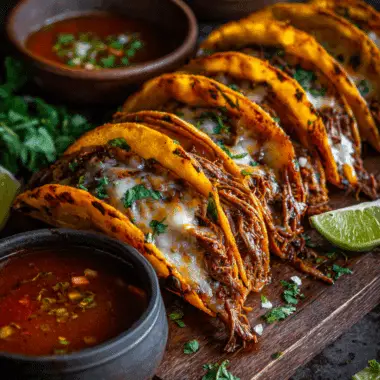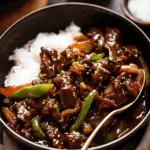Tamales are a cherished Mexican dish traditionally served during festivals, family gatherings, and especially during Mexican Independence Day celebrations. These delicious steamed masa (corn dough) pockets are filled with a variety of savory or sweet fillings, wrapped in corn husks, and cooked to perfection. Each bite offers a delightful combination of soft dough, flavorful meat or vegetables, and the earthy aroma of corn husks.
FULL RECIPE
Ingredients
1.For the Masa (Dough):
- 4 cups masa harina (corn flour for tamales)
- 2 teaspoons baking powder
- 1 teaspoon salt
- 1½ cups lard or vegetable shortening
- 3–4 cups warm chicken or vegetable broth
2.For the Filling (Pork version):
- 2 lbs pork shoulder, cut into chunks
- 6 cups water
- 2 cloves garlic
- 1 small onion, quartered
- Salt to taste
- 3 dried guajillo chilies, stemmed and seeded
- 2 dried ancho chilies, stemmed and seeded
- 1 teaspoon ground cumin
- ½ teaspoon ground black pepper
3.Other Ingredients:
- 25–30 dried corn husks
- Water for soaking husks
Directions
- Prepare the Corn Husks:
Soak corn husks in warm water for at least 1 hour until pliable. Rinse and drain before use. - Cook the Pork:
In a large pot, place pork, water, garlic, onion, and salt. Simmer over medium heat until tender (about 1.5 to 2 hours). Remove pork, shred, and set aside. Reserve the broth. - Make the Chili Sauce:
Toast guajillo and ancho chilies in a dry pan until aromatic (about 1–2 minutes). Soak in hot water for 20 minutes until soft. Blend with 1 cup of pork broth, cumin, and black pepper until smooth. Strain if desired. - Combine Pork and Sauce:
Cook shredded pork with the chili sauce over medium heat until the mixture thickens and flavors combine (about 15 minutes). - Prepare the Masa Dough:
In a mixing bowl, beat lard until fluffy. In a separate bowl, mix masa harina, baking powder, and salt. Gradually add masa mixture to the lard, alternating with broth until the dough is soft and spreadable (like peanut butter). Test by dropping a small piece in water—if it floats, it’s ready. - Assemble the Tamales:
Lay a softened husk flat. Spread 2–3 tablespoons of masa over the wide end, leaving a border. Add 1–2 tablespoons of pork filling in the center. Fold sides of husk inward, then fold the bottom up. - Steam the Tamales:
Arrange tamales standing upright in a large steamer with open ends facing up. Cover with a damp towel or extra husks. Steam for 1.5 to 2 hours or until the masa separates easily from the husks. Add water as needed to prevent burning. - Serve:
Let tamales rest for 10 minutes before serving. Serve with salsa, crema, or hot sauce on the side.
Nutrition Facts
- Calories: 280
- Total Fat: 15g
- Saturated Fat: 5g
- Cholesterol: 30mg
- Sodium: 350mg
- Total Carbohydrates: 27g
- Dietary Fiber: 3g
- Sugars: 1g
- Protein: 10g
- Iron: 1.2mg
- Calcium: 20mg
Cultural Significance of Tamales
Tamales hold a deeply rooted cultural importance in Mexican traditions, especially during national celebrations like Mexican Independence Day. They symbolize unity and heritage, often prepared in large batches by families working together. This communal cooking ritual fosters bonds between generations and preserves culinary customs. Tamales have existed since pre-Columbian times, evolving over centuries while retaining their original essence as portable, nourishing food. They are not just meals—they are a celebration of Mexican history and community spirit.
Types of Tamale Fillings
Tamales are incredibly versatile when it comes to fillings. While pork in red chili sauce is a popular traditional choice, other savory fillings include shredded chicken in green tomatillo salsa, beef with mole, cheese with roasted jalapeños, and vegetables with black beans. Sweet tamales are also common, filled with fruits like pineapple or raisins and sweetened masa colored with cinnamon or food coloring. The filling options are endless and often reflect regional ingredients and personal preferences.
Masa and Its Nutritional Value
The foundation of every tamale is masa, a dough made from masa harina, which is corn flour treated with lime (nixtamalization). This process enhances the bioavailability of niacin (vitamin B3) and improves digestion. Masa is naturally gluten-free and provides carbohydrates for energy. When prepared with vegetable shortening instead of lard, masa can become part of a healthier dietary choice. Fortified masa harina also contains calcium and iron, adding to its nutritional appeal.
Health Considerations
Tamales can be made to suit a range of dietary preferences and needs. Traditional recipes can be high in fat and sodium due to the use of lard and salty fillings. However, with modifications such as using lean meats, low-sodium broth, or plant-based ingredients, tamales can be transformed into a heart-healthy dish. Vegan and vegetarian tamales are gaining popularity for their lower fat content and increased fiber from vegetables and legumes.
Tamales for Special Diets
Because tamales are naturally gluten-free, they’re an excellent choice for individuals with gluten sensitivities or celiac disease. Vegan versions eliminate animal products entirely, substituting lard with vegetable oil or shortening and using creative fillings like mushrooms, squash, or vegan cheese. For low-carb diets, some variations use cauliflower masa or reduce the dough-to-filling ratio. This flexibility makes tamales adaptable to modern dietary trends without sacrificing flavor.
Serving Suggestions
Tamales are best served warm, straight out of the husk, and accompanied by traditional Mexican condiments like salsa verde, salsa roja, crema, or guacamole. They pair beautifully with pickled vegetables (escabeche), refried beans, and arroz rojo (Mexican red rice). For breakfast, tamales are often eaten alongside a hot beverage like champurrado (a thick chocolate drink) or atole (a sweet corn-based drink), making them a comforting, well-rounded meal.
Pairing Tamales with Drinks
Tamales pair wonderfully with both traditional and contemporary beverages. In Mexico, sweet drinks like horchata, tamarindo, or aguas frescas are common accompaniments. For adults, a cold Mexican beer, a smoky mezcal, or a tequila cocktail can enhance the dining experience. When serving sweet tamales, consider pairing with cinnamon-spiced coffee or vanilla-flavored atole for a cozy and balanced meal.
Storage and Reheating Tips
Tamales store exceptionally well, making them ideal for meal prep or leftovers. Once cooled, they should be wrapped in their husks and stored in an airtight container in the refrigerator for up to one week. For longer storage, tamales freeze well—just wrap them individually in foil or plastic and place them in a freezer bag. Reheat by steaming, microwaving with a damp paper towel, or warming in the oven wrapped in foil to maintain moisture.
Making Tamales in Advance
One of the best things about tamales is their make-ahead convenience. The components—masa, fillings, and husks—can be prepped days in advance. Fully assembled tamales can be refrigerated overnight or frozen until ready to steam. Many families make large batches and freeze portions to enjoy over several weeks. This approach saves time and allows for the joy of tamales any time of year, not just during holidays.
Regional Variations Across Mexico
Tamales vary greatly across Mexico’s regions, with each area showcasing its local flavors. In Oaxaca, tamales are often wrapped in banana leaves instead of corn husks and filled with complex moles. In Yucatán, tamales colados are made with strained masa and a thinner, custard-like texture. Northern Mexico offers tamales filled with beef and spiced with red chilies, while Central regions favor sweeter versions filled with raisins or candied fruits. This diversity highlights Mexico’s rich culinary tapestry.
Conclusion
Tamales are more than just a traditional dish they’re a symbol of heritage, celebration, and togetherness. With endless variations in fillings, regional styles, and cooking techniques, tamales continue to evolve while honoring their ancient roots. Whether prepared for a holiday feast or a comforting weekday meal, tamales offer a unique blend of flavor, culture, and nutrition.








